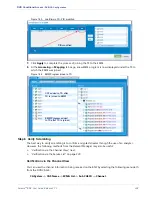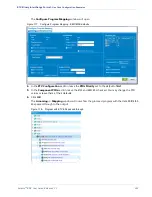
Selenio
TM
BNP User Guide, Release 3.7.1
237
- Functionality
Functionality
ETV is interpreted by a
User Agent
: a software application that runs on the set-top box that is installed
remotely by the MSO.
When ETV is downloaded to the STB, it uses a pairing of data elementary streams, which consist of the
following:
•
ETV Binary Interchange Format (EBIF) data ES — carries the application data.
•
ETV Integrated Signaling Stream (EISS) data ES — carries timing signals that trigger events
associated with the application.
ETV applications are typically “bound” (or
Pre-bound
) to particular pieces of content, and packaged in
a program together with video and audio while being broadcast to the STB. This content can be a 30-
second ad or a network stream (a dedicated channel or program with EBIF content coded into it).
Another possible source of ETV data is a local EBIF streamer: a server that provides pre-packaged EBIF
content, allowing the BNP to enhance a video or audio program (network stream or ad) with additional
ETV data. The process of adding EBIF enhancement to an existing network stream or ad is referred to as
Late-binding
.
shows the basic ETV data source flow.
Figure 169. ETV EBIF Data Source flow
Sat. Receiver
Sat. Receiver
BNP
BNP
DPI Pump
DPI Pump
STB
STB
Local EBIF
Streamer
Local EBIF
Streamer
QAM
QAM
Broadcast
Ad Insertion
Output Mux
Use Case Configuration Examples
The BNP can groom, splice or filter ETV data streams, including, but not limited to, the
Use Case
examples listed below:
1.
.
2.
Pre-Bound EBIF Passthrough (no DPI)
3.
4.
Pre-Bound EBIF Passthrough and Keep During Ad Splice
5.















































